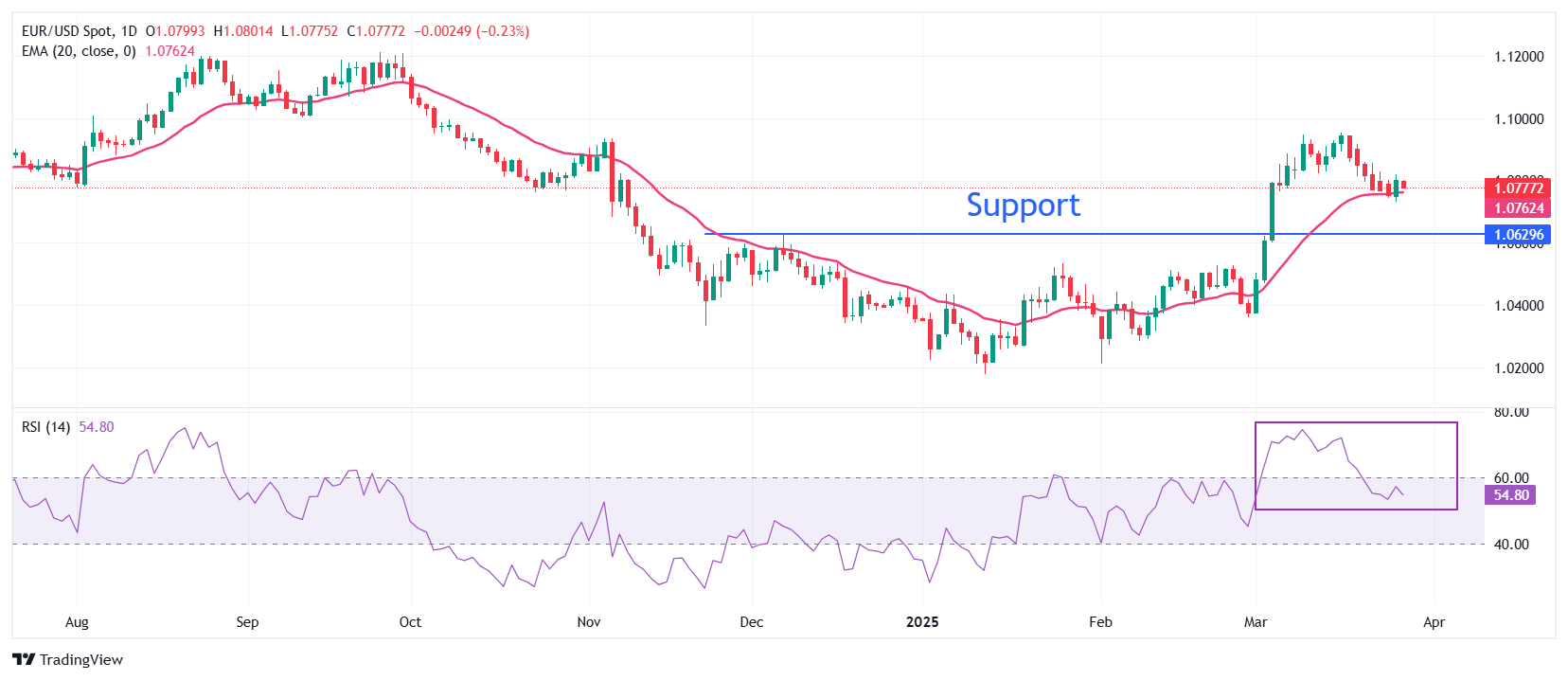EUR/USD Weakens Ahead Of US PCE Inflation, Trump’s Tariff Announcement
- EUR/USD faces pressure near 1.0800 as investors are cautious ahead of the US PCE inflation data for February.
- The European Commission prepares for retaliatory measures against US President Trump’s auto tariffs.
- Inflation in Spain and France grew at a moderate pace in March.
EUR/USD declines to near 1.0775 during European trading hours on Friday. The major currency pair faces pressure as United States (US) President Donald Trump is set to announce impending reciprocal tariffs on April 2.
The imposition of reciprocal tariffs by US President Trump is expected to weigh on economic growth and boost inflationary pressures across the globe, including the US. Trump also announced 25% tariffs on autos entering the US on Wednesday, which will become effective from April 2. Trump’s auto levy has resulted in global mayhem in automobile and auto-ancillary manufacturing companies' stocks.
Federal Reserve (Fed) officials have expressed concerns over a resurgence in price pressures in the near term due to Trump’s tariff agenda. "It looks inevitable that tariffs are going to increase inflation in the near term," Boston Fed Bank President Susan Collins said at an event on Thursday. Collins added that it seems more likely than not right now the increase in inflation will be “short-lived,” but warned of “potential risks” that higher price pressures could be persistent in nature. On the interest rate outlook, Collins said that holding them at their current levels for longer “is likely to be appropriate”. However, the Fed should show "active patience" and stand ready to be “flexible”.
In Friday’s session, investors will focus on the US Personal Consumption Expenditures Price (PCE) Index for February, which will be published at 12:30 GMT. Economists expect the US core PCE inflation, which is the Fed’s preferred inflation gauge, to have grown at a faster pace of 2.7% year-on-year, compared to the 2.6% increase seen in January.
The impact of the underlying inflation data is expected to be limited over the market speculation for the Fed’s monetary policy outlook as the central bank’s fate relies largely upon the consequences of Donald Trump’s economic policies.
Daily digest market movers: EUR/USD declines on potential US-EU trade war
- EUR/USD weakens amid deepening uncertainty over the Euro (EUR) due to potential risks of a trade war between the Eurozone and the US. The European Commission (EC) plans to announce retaliatory tariffs on the US for imposing a 25% blanket levy on autos. German carmakers dispatch 13% of their total auto exports to the US, and a 25% tariff on autos could make their cars less competitive in the global market.
- “We regret 25% auto tariffs and a new suite of measures coming on April 2, but we are preparing for all of these,” EC spokesman Olof Gill said on Thursday. When asked about the degree and timing of retaliatory measures, Gill refrained from guiding exact timings but assured that it will be “timely, robust, well calibrated and will achieve the intended impact".
- Financial market participants and German leaders warned that auto tariffs would be a lose-lose situation for both countries. “Trump’s decision is wrong," German Chancellor Olaf Scholz said on Thursday and added that the US has chosen a path at whose end “lie only losers” since tariffs and isolation hurt prosperity “for everyone”.
- Meanwhile, European Central Bank (ECB) officials expect Trump’s tariff agenda will hurt the Eurozone economic growth and boost inflationary pressures in the near term. ECB Vice President Luis de Guindos said that the impact of tariffs on inflation will be temporary, but it will be persistent on growth. "For growth, trade is extremely detrimental," de Guindos said and added, the "worst outcome is a vicious circle of tariffs/retaliation." On the monetary policy guidance, de Guindos said, "it is very difficult to say what ECB will do in April."
- On the economic front, France and Spain's March preliminary inflation data has shown that price pressures rose at a slower-than-expected pace. In 12 months to March, France’s Consumer Price Index (CPI) (EU Norm) rose steadily by 0.9%, slower than estimates of 1.1%. In the same period, Spain’s Harmonized Index of Consumer Prices (HICP) grew at a slower pace of 2.2%, compared to the prior release of 2.9%.
Technical Analysis: EUR/USD holds key 20-day EMA
(Click on image to enlarge)
EUR/USD drops to near 1.0775 on Friday but continues to hold the 20-day Exponential Moving Average (EMA), which trades around 1.0760.
The 14-day Relative Strength Index (RSI) cools down below 60.00, suggesting that the bullish momentum is over, but the upside bias is intact.
Looking down, the December 6 high of 1.0630 will act as the major support zone for the pair. Conversely, the psychological level of 1.1000 will be the key barrier for the Euro bulls.
More By This Author:
Pound Sterling Gains As UK Retail Sales Surprisingly Grew In FebruaryEUR/USD Recovers Further While Investors Ignore Potential US-Eurozone Tariff War
Pound Sterling Bounces Back Against US Dollar Despite Trump’s Tariffs On Automobiles
Information on these pages contains forward-looking statements that involve risks and uncertainties. Markets and instruments profiled on this page are for informational purposes only and should not ...
more



